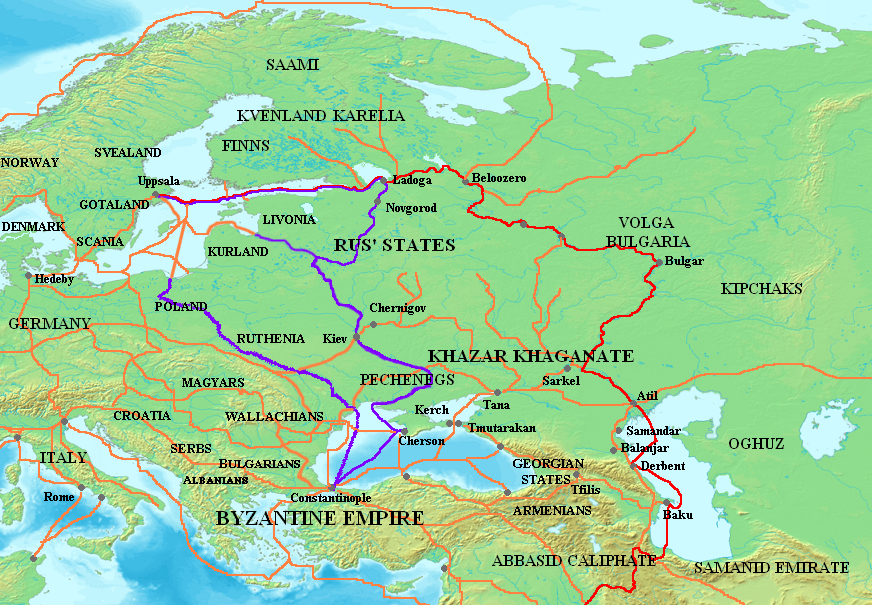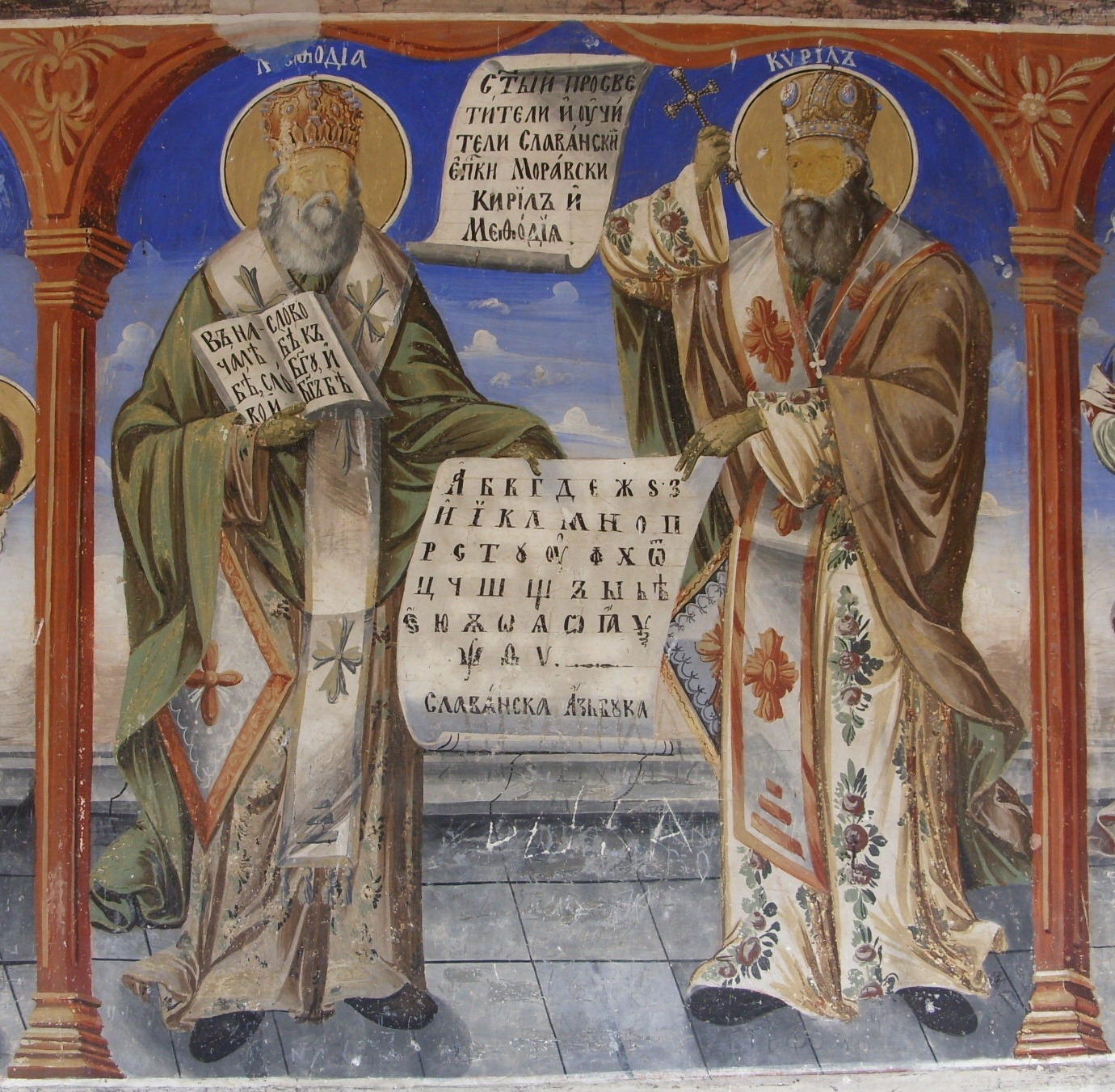I’ve always been fascinated by how small events can lead to massive changes—how one decision can lead to a ripple effect that alters the course of history forever.
In their own ways, the Cyrillic alphabet and Orthodox Christianity have played important roles in the shaping of Eastern European culture. The Cyrillic alphabet is used by around 250 million people around the world as the alphabet for their national language, and Eastern Orthodox Christianity is the second largest Christian Church—with over 250 million members.
The spread of Orthodox Christianity throughout eastern Europe would have likely failed, however, had it not been for the birth of the Cyrillic alphabet. Interestingly enough, the Cyrillic alphabet was born partially by accident… or was it divine intervention?

Sviatsolav I of Kiev
The Death of Sviatsolav I of Kyiv
During the 10th century modern-day Russia, Ukraine and Belarus were joined together in what was then known as Kievan Rus—a federation of Slavs ruled by the Rurik dynasty. The Rurik dynasty was founded by the Varangian (Scandinavian Vikings).
Kyiv was, strategically, a very important settlement. It’s location along the Dnieper allowed the Varangian to form a crucial trade route stretching from the north, all the way to Constantinople, and the Byzantine Empire—a vast, rich empire and trading partner.

Varangian Trading Routes
In the year 927, Sviatsolav, ruler of Kievan Rus, died. He had three sons. Two of his sons, Volodymyr and Iarpolk, were embattled in a feud for control of the empire. While familial feuds were very common in 10th century Europe, they would play a particularly prominent role in the failures of Rus over the next 800 years.
After many years of feuding, Volodymyr overthrew his half-brother and become Prince of Kyiv.

Volodymyr the Great
Legitimizing His Claim
Overthrowing his half-brother was just the beginning. People were accustomed to familial feuds by this point and wanted stability throughout the empire. Volodymyr’s people were in a state of discontent. He needed a way to legitimize his claim to the throne.
To accomplish this, he embarked on a campaign of religious persuasion. According to legend, he stood atop a hill in Kyiv overlooking the Dnieper, and announced that he would welcome all gods in his empire; Norse, Slavic, Finnish and even Iranian. His ploy worked.
In a sudden turn of events, however, he suddenly abandoned these Pagan gods, and adopted a new religion. Volodymyr was exceptionally violent in his abandonment of the Pagan gods—destroying statues, and symbolically dragging them through the streets.
Volodymyr went as far as to proclaim he who does not adopt this new religion will be his enemy. While some suggest Volodymyr was hasty in his decision to abandon the Pagan faiths, it’s clear that he spent a lot of time pondering the decision to switch faiths and researched multiple religions before making his final decision.
Many point to this moment as emblematic of Slavic culture—prone to extremes, never able to choose the middle ground.
Choosing A Religion

Several years into his reign, Volodymyr, sent emissaries through Europe to inquire into the teachings of several different religions. These religions were Islam, Judaism, Catholicism and Orthodox Christianity.
Record is perhaps hyperbolized here, but according to legend, he had no interest in Judaism, was unimpressed by Catholicism, and couldn’t fathom adopting Islam as it prohibited alcohol consumption. Alcohol was used as an effective tool to increase army morale and encourage male social bonding.
Volodymyr was thoroughly impressed with Orthodox Christianity and subsequently adopted Orthodoxy as the federation’s religion. While Rus’ sources say he was impressed with its beauty, it’s more likely he adopted Orthodox Christianity to strengthen his empires relationship with Byzantium—their largest trading partner at the time.
Secondary to strengthening his ties with Byzantium was that Orthodox Christianity legitimized his monarchial power, and demanded law and order throughout the empire… and for an empire in a state of near-chaos, Orthodoxy provided an optimistic respite.
The initial reaction to Volodymyr adopting Orthodox Christianity was initially negative, as for years the Slavs had been Pagans. What allowed Orthodox Christianity to succeed and flourish in eastern Europe, however, was something that happened, almost by accident, nearly a century earlier.
Divine Intervention
In 860 AD, Byzantium dispatched two Theologians, Cyril and Methodius, to convert Pagans in Europe, beginning in Moravia—modern day Czech Republic. To do this, Cyril and Methodius learned the Slavonic language spoken in Moravia and devised an alphabet for it. This alphabet was called the Glagolitic Script, and is the oldest known Slavic alphabet.

Saint Cyril and Methodius
The Glagolitic Script did not receive much support in Moravia. The Germanic clerics in the region convinced Moravians that the Latin language was the only way to properly read, and recite scripture.
Moravia ended up not adopting the Glagolitic script, eventually banishing Methodius and Cyril from their empire. Seeking refuge, the brothers traveled to Bulgaria. Khan Boris of Bulgaria wanted Methodius to help him create an alphabet for their language.

The Glagolitic Script
Khan Boris and his son eventually adopted and introduced Orthodox Christianity to his empire, with a brand new alphabet modelled on the Greek language—as opposed to the Glagolitic script, which was based on unknown sources—perhaps a loose mixture of Greek or other alphabets.
This new alphabet was known as the Cyrillic script, and helped spread Christianity throughout Bulgaria and Eastern Europe like the plague. Without this script, Orthodox Christianity would have not spread; Catholicism was already beginning to encroach on eastern European borders.
Orthodoxy Christianity Makes Its Mark On Rus
Eventually, Volodymyr married the sister of the Byzantine emperor, further strengthening the relationship between the two major empires at the time. After this marriage, and the adoption of Orthodox Christianity, Eastern Europe changed forever.
Greek craftsmen spread throughout Kievan Rus, building churches wherever they went. Bulgarian clerics appeared throughout the empire with their holy books and using the Cyrillic script in the Slavonic language—easily converted people. This led to a major shift in law, with a larger focus on ecclesiastical decree.
Blood feuds, at least for a time, were reduced. Marriage and social bonds were strengthened, people were more optimistic, and the monarchial rule of Volodymyr was affirmed, as well as the legitimacy of his reign.
The rest is history. Orthodoxy spread like wildfire, despite facing some tough tests later in Moscow. In Moscow and western Russia (notably, Novgorod) there was a conflict between Christianity, and Catholicism (the Lithuanian-Polish empire was Catholic). Some Russian citizens despised how Orthodoxy was being interpreted to create an authoritative, monarchial power, and veered towards adopting Catholicism for the prospect of a better life.
Nevertheless, Orthodoxy and the Cyrillic alphabet have stood the test of time. Had Saint Methodius and Cyril not been sent to Moravia, had they not survived, had they not been banished by Moravia (or had they been killed instead), it’s very likely that Catholicism would have prevailed, and would have eventually westernized Eastern Europe, destroying the traditional values that we admire today.
Read More: The Orthodox Church Is The Answer To Reviving Christianity In Europe And Saving The West